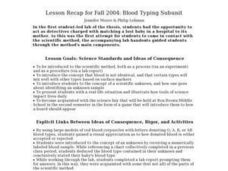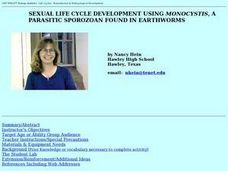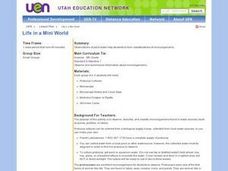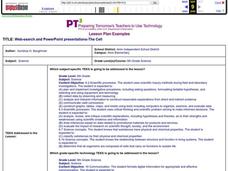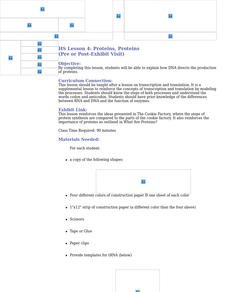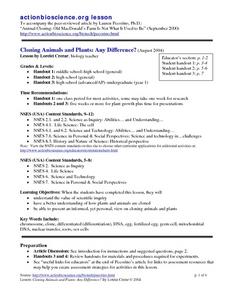Curated OER
DNA, RNA, Protein Synthesis, & Mutation
In this biology worksheet, students identify and label the diagram shown by stating what each part of the diagram represents on the line. Then they use the DNA strand as the original strand and complete the data table. Students also...
Curated OER
Interesting Insects
In this insects worksheet, students read about insects and then answer the 10 questions pertaining to what they just learned. The answers are on the last page.
Curated OER
No Escape
Via four student handouts, marine biology learners examine the topography and circulation cell of the Fieberilng guyot. Then they examine the number of individual hydroids counted at each depth. Pupils use the information to relate water...
Curated OER
Mass Measurement
Middle schoolers explore geometry by completing a physics activity on-line. In this mass measurement lesson, pupils define the terms mass, volume, and density and identify their relationship with each other. They complete an on-line...
Curated OER
Blood Typing Subunit
Students play the role of science detectives in an activity used to introduce the scientific method and the concept that blood is not identical and is identified by surface markers. Students must identify an unknown sample of "blood" by...
Curated OER
Albinistic Animals Are Awesome
Are all academicians allured with alliteration? Use this cross-curricular online resource to simultaneously expose your scholars to parts of speech and the genetic mutation causing albinism. Initial context gives students an introduction...
Curated OER
SEXUAL LIFE CYCLE DEVELOPMENT USING MONOCYSTIS
High schoolers perform a lab to becoe familar with scientific concepts. The skill of inquiry is essential and this lesson furthers its development. The intelligence of kinesthetics is used as learners perform the many aspects of this lab...
Curated OER
Experiment on Minimal Segment Size Regeneration of Lumbriculus variegatus
The experiment allows young scholars to observe regeneration of tailless and headless worm segments into complete individuals. Data of a completed experiment are included as well as a student activity sheet.
Curated OER
Diversity of Life
Pupils identify the difference between eukaryote and prokaryotes and examine the structure of bacteria. In this bacteria lesson students examine the different ways that bacteria are classified through an activity.
Curated OER
Life in a Mini World
Sixth graders observe, describe, and classify microorganisms found in water sources. In small groups, they make their own slide, observe the Protozoa under a microscope, and record and classify the microorganisms.
Curated OER
Web-search And PowerPoint Presentations-The Cell
Sixth graders create a PowerPoint presentation using information that they have compiled from their web search and rubric web sites, text and other applicable references. They work in pairs to complete these searches and projects.
Curated OER
Feed Your Cells
Students examine and research the human digestive system and what happens to the food we eat. They read the article, The Passage of Food, participate in an experiment with crackers, and write a paragraph summarizing the function of the...
Curated OER
The Life Of Bees
Students explore the matriarchal structure of a bee colony. They participate in various activities to identify the structure of a bee colony and the roles of each type of bee plays in the colony. Vocabulary and a worksheet with answer...
Curated OER
The Energy of Life in Zebrafish
Students study the stages of development of an unknown organism. In this zebrafish lesson, students examine and collect data as they use microscopes to view a zebrafish embryo.
Curated OER
Genome: The Secret of How Life Works
Students explain how DNA directs the production of proteins.
Curated OER
Ego Trip- Exploring the Inner Workings of the Human Body
Students gain an understanding of how systems and organs in the human body work. They create their own fictional account of a trip through the human body, and describe one response the body makes to stimuli.
Curated OER
Basic Vitamins: Water-Soluble and Fat-Soluble
An incredibly thorough lesson on vitamins, and how to keep one's body at peak health. Learners access a variety of excellent worksheets embedded in the plan that have them consider raw vs. cooked foods, a vegetable nutrition summary,...
Curated OER
Lab Experiments in Nutrition
Looking for authentic hands-on nutritional experiments? High schoolers will perform experiments to test for the presence of vitamin C in several solutions as well as the effect of caffeine on Daphnia. They will also consider the...
Curated OER
Photosynthesis Cookies
Students identify photosynthesis as a process through which organisms make their own food. They practice the process for writing the formula for the photosynthesis equation.
Students describe how the processes of photosynthesis and...
Curated OER
The Wonders of Bacteria
Learners explore the evolution and features of bacteria through a series of activities. In this biology lesson, students collect data and graph bacterial growth. They design a brochure about bacteria's role in society.
Curated OER
Photosynthesis Lesson Plans
You can teach students about the importance of plants and the process of photosynthesis with motivating lesson plans. Follow along and find out how one science teacher uses experiments, stories, and her love of plants to get kids excited...
Curated OER
Organ Systems
Young scholars examine organisms that are composed of tissues, organs, and systems. They dissect a fetal pig and explore the assigned organs systems such as the skeletal, muscular, and circulatory organs. Students identify and explain...
Curated OER
Cloning Animals and Plants: Any Difference?
Students examine the process in which plants and animals are cloned. They compare and contrast the two procedures and determine if there is a difference. They share their views on cloning to the class.
Curated OER
The Plasma Membrane
In this plasma membrane worksheet, students will explore how cells are able to maintain homeostasis and the function of the plasma membrane. This worksheet has 6 fill in the blank and 7 true or false questions.






